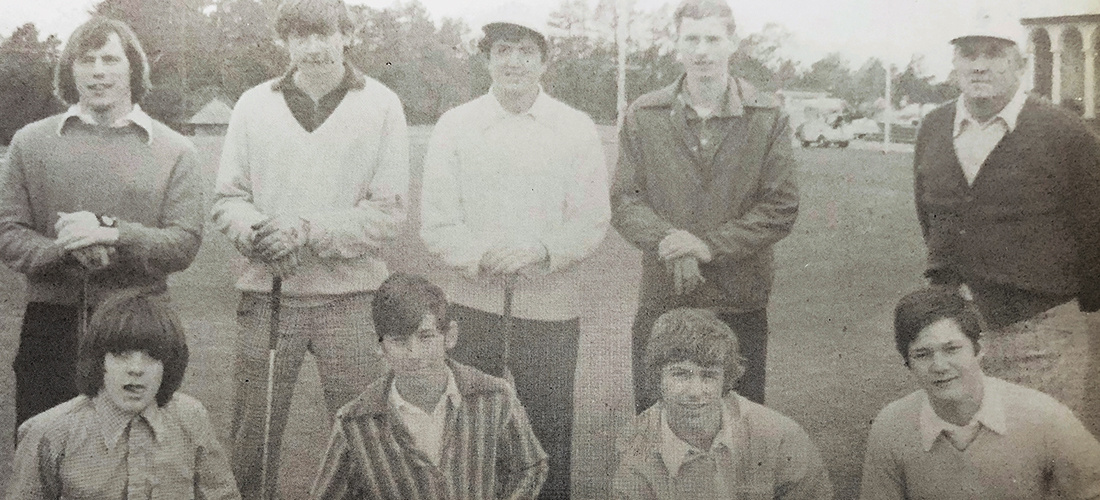
The Boys of Spring
Toting dreams of breaking par
By Bill Fields
We were a mostly scrawny bunch dressed in sharp collars and loud pants, convinced that with a bit more practice and little more luck, we could be the next Tom Watson. This ignored the fact that most of us on the Pinecrest Patriots boys golf team during the mid-1970s considered breaking 80 an excellent day, but there was no point in letting the facts get in the way of our dreams.
By this time of year, the season would have begun after a couple of weeks of practice. Cool weather wasn’t a problem. If one of those cheap nylon jackets didn’t do the trick, there was always orlon or velour on reserve. My first match during my sophomore year, on March 3, 1975, happened to coincide with my parents’ anniversary. That evening Dad splurged on dinner for the three of us at Cecil’s in the Town and Country Shopping Center. The steak was better than my score, 84.
Pinehurst No. 1 was our home course for practice and matches, and I came to know it well over those years of preparation and competition. I even prepared a rudimentary yardage book in a First Union pocket calendar. There was the fear of the O.B. fence to the right of the opening fairway and the fun of trying to bag an early birdie on the reachable par-5 fourth. In those years No. 1 concluded with a short par-3. Everyone who had finished would gather around the green, a rare gallery that made the 8- or 9-iron shot harder — and the walk to the parking lot longer if you botched it and bogeyed.
Despite my familiarity with the course, the best I shot there — or anywhere else during prep play — was 72 during a match senior year as the team combined for a four-man total of 292, a school record at that point in Pinecrest’s young history. Although we were proud Patriots that particular Monday afternoon, more recent generations would scoff at our scores. Pinecrest’s young men and women have won multiple state titles in recent years, becoming the powerhouse you would have thought prep golfers in a golf-rich area would have been all along.
We made it to the state tournament once, in 1975, which in those years was played at Finley Golf Course in Chapel Hill. Shooting an opening round 89 was bad enough, but that evening, while we were horsing around outside after eating, I got stung by a wasp over my left eye. By morning, it was swollen partly shut, which didn’t help my cause. It is never a good sign when you don’t have enough fingers to signal how many over par you are to a teammate in an adjacent fairway. I played terribly on the front nine, shooting 52.
But the eye started to get better as I made the turn, and I vowed to turn things around to avoid complete embarrassment. Somehow, I did, making three birdies, three pars and three bogeys to shoot an even-par 36 and break 90. If that 16-stroke improvement between front and back isn’t a state record, it must be in the neighborhood.
Golf was not a priority at the school. The football team got a sit-down pre-game meal of steak and potatoes at Russell’s before its Friday night game. Our golf coach stopped the station wagon or van at McDonald’s as we traveled to an away match. As for staying hydrated during a round, we hoped there was a functioning water fountain somewhere on the course.
Two of the courses we played in conference matches — Arabia in Hoke County and Richmond Pines in Rockingham — closed years ago. Others remain, such as Scotch Meadows in Laurinburg and Pinecrest Country Club in Lumberton. Quail Ridge, in Sanford, home to the sectional tournament my sophomore and junior years, is still around. So is the Sanford Municipal Golf Course, site of the sectional in May 1977 during my senior year.
The good form that I’d shown earlier that season was gone by the time we arrived in Lee County trying to advance to the state tourney. I was not going to be the next Tom Watson after all. Our fourth-best score that day as the team successfully advanced was an 85, so I was north of that. I believe I shot 89, or it could have been even higher. My high school golf career ended not with a whimper but to the sound of constant beeping from machinery at the nearby brick company. If the trucks were in reverse, so was my game, at just the wrong time. PS
Southern Pines native Bill Fields, who writes about golf and other things, moved north in 1986 but hasn’t lost his accent.





